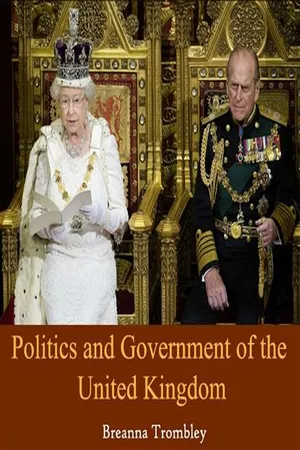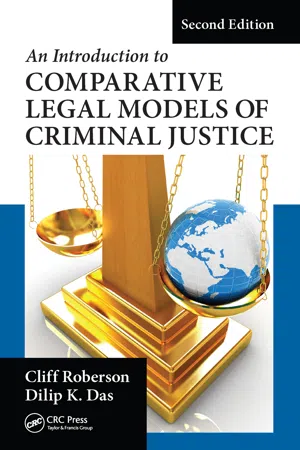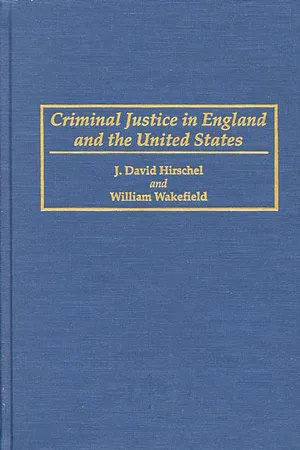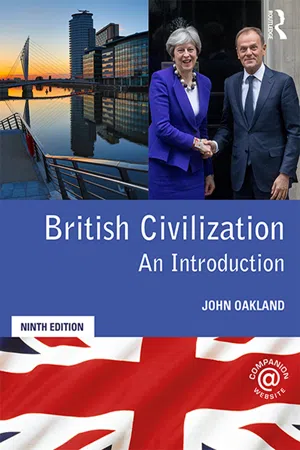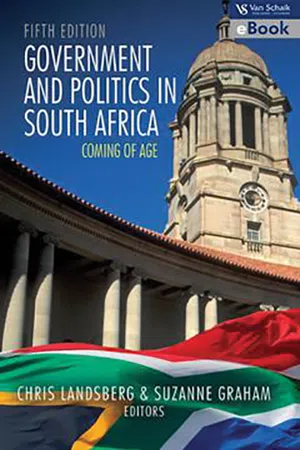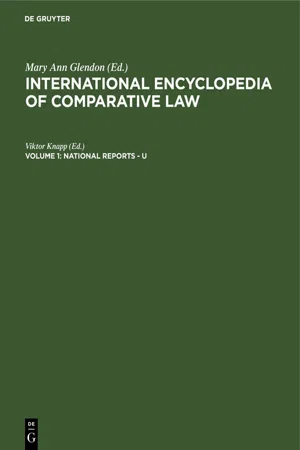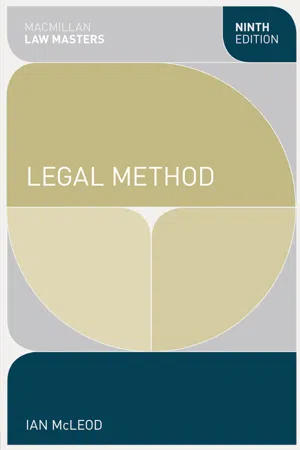Law
UK Court System
The UK Court System is a hierarchical structure comprising various courts, including the Supreme Court, Court of Appeal, High Court, and lower courts. These courts handle civil, criminal, and administrative cases, with the Supreme Court serving as the final court of appeal. The system operates under the principle of judicial independence and aims to provide fair and impartial justice.
Written by Perlego with AI-assistance
Related key terms
1 of 5
10 Key excerpts on "UK Court System"
- No longer available |Learn more
- (Author)
- 2014(Publication Date)
- Learning Press(Publisher)
Recent constitutional changes saw a new Supreme Court of the United Kingdom come into being in October 2009 to take on the appellate functions of the Appellate Committee of the House of Lords. In England and Wales, the court system is headed by the Supreme Court of England and Wales, consisting of the Court of Appeal, the High Court of Justice (for civil cases) and the Crown Court (for criminal cases). The Courts of Northern Ireland follow the same pattern. In Scotland the chief courts are the Court of Session, for civil cases, and the High Court of Justiciary, for criminal cases. Sheriff courts have no equivalent outside Scotland as these Courts deal both with criminal and civil caseloads. The Judicial Committee of the Privy Council is the highest court of appeal for several independent Commonwealth countries, the British overseas territories, and the British Crown dependencies. There are also immigration courts with UK-wide jurisdiction — the Asylum and Immigration Tribunal and Special Immigration Appeals Commission. The Employment tribunals and the Employment Appeal Tribunal have jurisdiction throughout Great Britain, but not Northern Ireland. Three legal systems There are three distinct legal jurisdictions in the United Kingdom: England and Wales, Northern Ireland and Scotland. Each has its own legal system. ________________________ WORLD TECHNOLOGIES ________________________ English law The Royal Courts of Justice in London, home of the Supreme Court of England and Wales English law is a term of art. It refers to the legal system administered by the courts in England and Wales, which rule on both civil and criminal matters. English law is renowned as being the mother of the common law, and is based of those principles. English law can be described as having its own distinct legal doctrine, distinct from civil law legal systems since 1189. - Clare Seymour, Richard Seymour(Authors)
- 2011(Publication Date)
- Learning Matters(Publisher)
Ireland was first invaded from England, or, more accurately, from Wales, in 1169. From then on a presence of Normans, English and Welsh spread throughout the country and English law was applied to the parts of Ireland controlled by the English king. The law which applied in Ireland was modified by laws passed when there was a Parliament in Dublin, but in 1801 Ireland joined the United Kingdom. For the next 120 years, Parliament in London passed laws applicable only to Ireland, as well as laws which applied throughout the United Kingdom. In 1922 the Republic of Ireland became independent, with Northern Ireland remaining in the United Kingdom. At times Northern Ireland has had its own Parliament and passed its own laws, but, as in the case of the Republic of Ireland, the laws and structure of its courts remain similar to those of England. These laws are not English law, however, and therefore the next chapter concerns the legal system of England and Wales.FURTHER READING
Baker, J H (2002) An introduction to English legal history (4th edition). London: Butterworths.This text traces the development of the principal features of the English legal system which helps explain the operation of the present system.Passage contains an image
Chapter 2 The English legal system in practice
This chapter will help you to meet the following National Occupational Standards for social work.- Key role 1: Prepare for, and work with individuals, families, carers, groups and communities to assess their needs and circumstances.
- Assess needs, risks and options taking into account legal and other requirements.
- Key role 6: Demonstrate professional competence in social work practice.
- Review and update your own knowledge of legal, policy and procedural frameworks.
Introduction
Here we explore the nature and responsibilities of courts and lawyers and the relationships between them, encouraging you to develop an ability to undertake an informed and critical assessment of the operation of the English legal system. We also briefly consider future developments.ACTIVITY 2.1
Review your current knowledge and learning needs:- What experience have you had of courts?
- In which areas of court work do you feel most, and least, confident?
- In what circumstances have you wished you knew more about courts?
- What barriers do you think you may face in developing courtroom skills?
- What might help you overcome these barriers?
Organisation of the courts
The English legal system is big business. Her Majesty’s Courts and Tribunals Service (HMCTS), an executive agency of the Ministry of Justice, has 21,000 staff and operates from around 650 locations. It is responsible for the work of more than 30,000 magistrates and judges, plus supporting staff, who deal with around 2 million criminal prosecutions, 1.8 million civil claims, more than 150,000 family law disputes and around 80,000 tribunal cases annually.- eBook - PDF
- Bryan Clark, Gerard Keegan(Authors)
- 2014(Publication Date)
- EUP(Publisher)
The Act also put an end to the previous judicial roles of the Lord Chancellor and the Law Lords. THE SCOTTISH JUDICIAL SYSTEM 59 The Supreme Court of the United Kingdom The Supreme Court is the final court of appeal in the UK for civil cases. It hears appeals in criminal cases from England, Wales and Northern Ireland, and hears cases of public or constitutional importance affecting the whole population. Judges who sit in the Supreme Court are called Justices of the Supreme Court of the United Kingdom. Cases involving “devolution issues” arising from the Scotland Act 1998 concerning the validity of Acts of the Scottish Parliament, or questions arising over executive functions of the Scottish Government are heard by the Supreme Court. Such cases may reach the Court after referral by the Advocate General. The Advocate General is one of the Law Officers of the Crown, whose duty it is to advise the Crown and UK Government at Westminster on Scots Law. The impact of Supreme Court decisions extend far beyond the parties involved in any given case, shaping our society, and directly affecting our everyday lives. As stated, the Supreme Court came into being in 2005 to achieve separation between the UK’s senior Judges and the Upper House of Parliament. The reason being was to emphasise the independence of the Law Lords and increase transparency between Parliament and the courts. In August 2009, the new Supreme Court Justices moved out of the House of Lords into their own building on the opposite side of Parliament Square.They sat for the first time as a Supreme Court in October 2009. In their first legal year, the Supreme Court gave landmark rulings on access to legal advice for Scottish suspects, the rights of gay asylum seekers, and the weight to be given to pre-nuptial agreements. The Supreme Court, as well as being the final court of appeal, plays an important role in the development of UK law. - Cliff Roberson, Dilip K. Das(Authors)
- 2016(Publication Date)
- Routledge(Publisher)
The Crown Court is an intermediary court that is above the magistrates’ courts but below the High Court of Justice and the Court of Appeal. The Crown Court is concerned mostly with criminal cases. It hears trials on indictment, as well as sentencing and appeals from the magistrates’ courts. There are six court circuits: Southeastern (with London as the administrative center); Wales and Chester (with Cardiff as the center); Western (Bristol); Midland and Oxford (Birmingham); Northeastern (Leeds); and Northern (Manchester). The Crown Court is governed under the directives of the lord chief justice, with the agreement of the Lord Chancellor.Royal Courts of Justice
The Royal Courts of Justice, also called the Law Courts, is housed in a Victorian Gothic structure designed by George Edmund Street, who died during its construction. Located in London, it includes several towers, more than a thousand rooms, and ornate decorations and furnishings. The building is a complex of courtrooms, halls, and offices concerned primarily with civil (noncriminal) litigation. Statues of Christ, King Solomon, King Alfred, and Moses are placed above its main doors. Its main hall is about 240 feet long and 80 feet wide. Extensions were added to the building in 1911 and 1968. It lies in the Greater London borough of Westminster on the boundary with the City of London. Within the complex are held sessions of the Court of Appeal, the High Court of Justice, and the Crown Court.Comparisons between the United States and the United Kingdom
The United Kingdom and the United States have been described as “two countries separated by a common law” because there are so many differences between them in terms of the legal framework. One of the major differences is that the United Kingdom has no written constitution and no judicial review, whereas every court in the United States possesses the power to pass judgment on the constitutionality of legislation and on other official actions. Another major difference is that the United States has a very complex federal court system and its relationship to state court systems is difficult to understand, whereas the United Kingdom has one unitary system.Both nations appear to placing an increasing reliance on statute law and codification as instruments of legal development. When the United Kingdom entered the European Economic Community, it was thought that there might be pressures to make English law more accessible by codifying it along the lines of the Continental model. Harmonization of the laws of the member states, however, has not thus far required this.- David Hirschel, William Wakefield(Authors)
- 1995(Publication Date)
- Praeger(Publisher)
Part III The Judicial System of England This page intentionally left blank Chapter 7 The Criminal Courts, Judges, and Lawyers In this chapter we shall examine the structure of the English court system and the qualifications, duties, and powers of the various officials who appear in the courts: the judges, lawyers, and other court officials. The court process itself will be investigated in chapter 8. STRUCTURE AND JURISDICTION OF THE COURTS In England there are two levels of courts of original jurisdiction (courts that actually hear and decide cases). There are four levels of courts of appellate jurisdiction. The two courts of original jurisdiction are the Magistrates' Courts and the Crown Courts. The four courts with appellate jurisdiction are, in ascending order, the Crown Courts, the Divisional Court of the Queen's Bench, the Criminal Division of the Court of Appeal, and the House of Lords. Magistrates' Courts The Magistrates' Courts are the courts of inferior jurisdiction, the courts that are responsible for trying the less serious summary offenses. As indicated in chapter 3, in England crimes are categorized as being (1) summary, in which case they are tried in the Magistrates' Court; (2) indictable, in which case they are tried in the Crown Court; or (3) either summary or indictable, in which case they can be tried in either court. With regard to cases that can be tried in either court, it is the magistrates who make the initial determination of whether the case is more suitable for summary no The judicial System of England trial or for trial on indictment (Magistrates' Courts Act of 1980, sec. 19). A defendant must, however, consent to the case being tried in summary fashion (sec. 20). If the defendant does not consent, the case will be tried on indictment in Crown Court. A defendant may believe that there is an advantage in the case being tried in Crown Court where, unlike in Magistrates' Court, the case is heard by a jury.- eBook - ePub
British Civilization
An Introduction
- John Oakland(Author)
- 2019(Publication Date)
- Routledge(Publisher)
7The legal system- Legal history
- Sources of British law
- Court structures in England and Wales
- Civil and criminal procedure in England and Wales
- Law and order
- The legal profession
- Attitudes to the legal system and crime
- Exercises
- Further reading
- Websites
Legal structures have played a central part in British civilization for many centuries. Initially, leaders or monarchs, and then Parliament created the law; lawyers and the courts have serviced it; and all citizens are subject to it. It has been influenced by social conflict, political struggle and constitutional change. This chapter examines its history, the main elements that comprise it today, and the problems that it faces.Law and order, and the actions of the legal system are of concern to the British people and affect individuals at different levels in their daily lives. Legal issues regularly appear in opinion polls about the state of the country, and include the need for accurate figures of crime offences, anti-social behaviour, violence on the streets, yobbishness, security and terrorism issues, cybercrime and the monitoring of communications systems, and cuts in police forces. Opinions differ on whether the legal system has been able to deal effectively with these concerns.Britain does not have a common legal system. Instead, there are three separate elements: those of England and Wales, Scotland, and Northern Ireland. These sometimes differ from each other in their laws, procedures and court names. Following devolution, some laws are applicable only to individual devolved nations, although UK Parliament legislation on reserved matters still applies to all of Britain.To simplify matters, this chapter concentrates on the largest element: that of England and Wales, with comparative references to Scotland and Northern Ireland. The Northern Irish legal system is similar to that of England and Wales. But Scotland has historically had its own independent legal apparatus. - eBook - ePub
Law for Criminologists
A Practical Guide
- Ursula Smartt(Author)
- 2008(Publication Date)
- SAGE Publications Ltd(Publisher)
2 THE LEGAL SYSTEM OF ENGLAND AND WALESOverviewChapter 2 examines:- The sources of English law
- The constitutional and administrative structure of the UK Parliament and its law-making powers
- The nature of the English civil and criminal court system and its key personnel
- The changing nature of other civil courts, such as the coroner’s court, tribunals and inquiries
Chapter 2 introduces you to the English legal system, so that you get a good grounding in basic legal principles and sources of law. In order to understand how legislation comes about in the form of statutes (Acts of Parliament), you need to understand the set up of the UK Parliament before you embark on criminal procedure.There has long been a heated debate in Parliament whether the UK should have a written constitution, similar to its continental European partners, but the strong arguments protecting cultural heritage and legal flexibility in a multicultural society have so far prevailed.This chapter promotes greater understanding of the English court system to encourage you to participate in criminal as well as civil court proceedings as an observer, so that you can see how the law works in practice.2.1 Sources of law
There are four major sources of law:- Custom
- Common law (‘judge-made’ or ‘case law’)
- Acts of Parliament (‘statutes’ or ‘legislation’)
- European Union law
There are very few examples of customary law, but custom usually applies to local or geographical rights. Did you know, for example, that the law requiring a London taxi driver to carry a bale of hay on top of his cab to feed the horse was in force until 1976? Or that Welshmen are not allowed in the city of Chester after dark? Or that fishermen in Lowestoft have the right to dry their nets on someone else’s land? (see Elliott and Quinn, 2008: 94). Custom enters a legal dispute when one party alleges that they have had a particular right to do something since ‘time immemorial’. This has to be at least since 1189 (see Cawthorne, 2004). - eBook - ePub
- Landsberg C, S Graham(Authors)
- 2017(Publication Date)
- Van Schaik Publishers(Publisher)
694The legal system and the judiciary
Roxan Venter1The following key issues are dealt with in this chapter:- The nature of law and of the judicial function
- The origins and nature of the South African legal system
- How law is classified and the sources and contents of South African law
- The South African court system
- The independence of the courts
- The judicial process and procedures that are followed in civil and criminal cases
- The role and influence of the judiciary in the political system
4.1 Introduction
Every state has a legal system comprising the rules of law that apply in that state. Everybody, from the different organs of state to the individual, is engaged daily in the application of those rules of law to their relationships. Every state also has a judicial branch of government that resolves, on an authoritative basis, disputes that arise between members of society, by the application of the appropriate rules of law. Within the trias politica, the judiciary, as the third branch of government, therefore has the key function of ensuring that everybody – the people as well as all organs of state – abides by the law.4.2 The nature of the law
The notion of an independent judiciary that applies the law impartially and without fear, favour or prejudice is generally accepted as a cornerstone of democracy. But what is law, and what is the nature of the judicial function? It has been said that law consists of rules that dictate how we must or must not act as members of society (Rautenbach & Malherbe, 2009: 2). As there are many other rules that govern our conduct, such as the rules laid down by parents for their children, associations for their members, and universities for their students, the question to be answered is: when can rules be described as law?There is one determining factor, which distinguishes rules of law from other rules that apply in society: only rules of law can be enforced by the State (Rautenbach & Malherbe, 2009: 4). There are different reasons for this. Firstly, 70 - eBook - PDF
National Reports - U
Uganda, Union of Arab Republics, Union of Soviet Socialist Republics, United Arab Emirates, United Kingdom, United Kingdom Dependent Territories, United States of America, Upper Volta, Uruguay
- Viktor Knapp(Author)
- 2020(Publication Date)
- De Gruyter(Publisher)
This measure, and the implementation of it by the Court, was highly controversial and unpopular generally with the Trade Union movement. This Court was abolished by the Trade Unions and Labour Relations Act, 1974 (c. 52), s. 1 (3). In September 1974 the Secretary of State for Em-ployment set up an independent Industrial Con-ciliation and Arbitration Service. In addition, there are a large number of ad-ministrative tribunals set up under Acts of Parlia-ment or under powers conferred by statute which have quasi-judicial and/or administrative respon-sibilities (e.g., Lands Tribunal, local tribunals under the National Insurance Acts, Pensions Appeal Tribunals, Rent Tribunals). The Tribunals and Inquiries Act, 1958 (6 8c 7 Eliz. 2, c. 66) provided for the establishment of a Council of Tribunals with the duty of supervising the constitution and working of many of these tribunals; the same Act provided for a right of appeal to the High Court on a point of law from certain tribunals. (4) The House of Lords. -The House of Lords, when sitting as a judicial tribunal, is the highest court in the United Kingdom. It is composed of the Lord Chancellor (who presides), ex Lord Chancellors, peers who have held high judicial office, and a number of Lords of Appeal in Or-dinary, who are life peers; by convention lay peers do not attend. It is the final appellate tribu-nal in both civil and criminal cases from England and Wales; it hears appeals from both the civil and criminal side of the Court of Appeal, and from Scotland and Northern Ireland. It also hears appeals from the Courts-Martial Appeals Court. (5) The Judicial Committee of the Privy Council. -Reference has been made above to the role of the Privy Council in government (see supra I 3); the Judicial Committee of the Privy Council is com-posed of Privy Councillors (including the Lords of Appeal in Ordinary (see supra (4)) who hold, or have held, high judicial office in the United King-dom or in Commonwealth countries. - eBook - PDF
- Ian McLeod(Author)
- 2020(Publication Date)
- Red Globe Press(Publisher)
Rights of appeal and permission to appeal There have been various references throughout this chapter to rights of appeal. Whether there is any right of appeal in a given situation will always depend on the relevant statutory provisions. However, as a very general proposition, where there is a right of appeal there will often be one appeal on the facts and the law, but with the possibility of further appeal on the law only. It is also worth noticing that some rights of appeal are conditional, in the sense that permission to appeal must be obtained before the right is exercised. Depending on the detailed statutory provisions in question, permission may be obtainable either from the court whose decision is being challenged or from the court which will deal with the appeal if it proceeds. Summary ◗ The structure of the courts’ system within the English legal system is hierarchical. ◗ The principal classification of the jurisdictions of the courts is into first instance and appellate , and into civil and criminal . 3.10.3 3.11 Legal method 60 ◗ The magistrates’ courts’ jurisdiction has both civil and criminal elements. It is exercisable at first instance and, in some minor civil matters, on appeal. ◗ The Crown Courts’ jurisdiction has both civil and criminal elements, and is exercisable both at first instance and on appeal. ◗ The County Courts’ jurisdiction is entirely civil, and is exercisable principally at first instance but also to some extent on appeal. ◗ Although the High Court is nominally one court, for administrative purposes it is split into three parts, namely the Queen’s Bench Division, the Chancery Division and the Family Division. As a whole, the High Court’s jurisdiction comprises both civil and criminal matters, and is exercisable both at first instance and on appeal. The Queen’s Bench Division also has a supervisory jurisdiction. ◗ Although the Court of Appeal is nominally one court, it is divided into the Criminal Division and the Civil Division.
Index pages curate the most relevant extracts from our library of academic textbooks. They’ve been created using an in-house natural language model (NLM), each adding context and meaning to key research topics.
